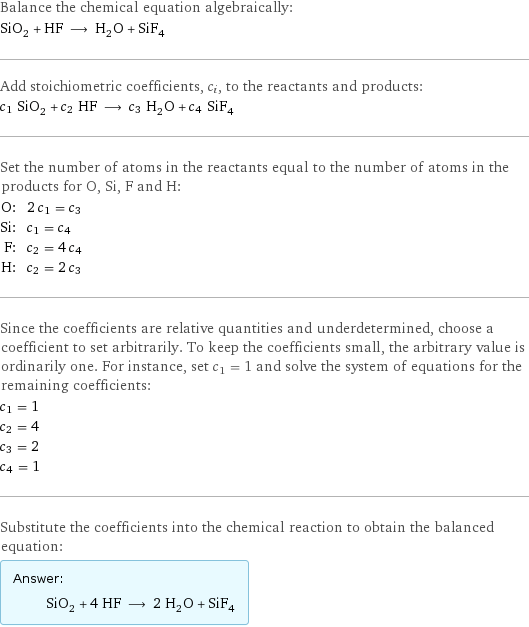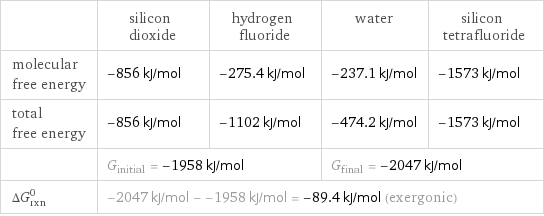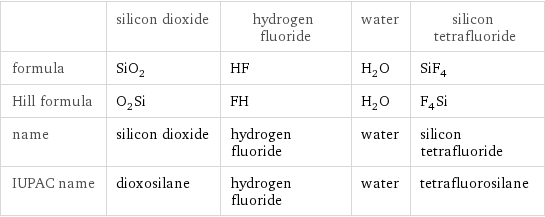Input interpretation

SiO_2 (silicon dioxide) + HF (hydrogen fluoride) ⟶ H_2O (water) + SiF_4 (silicon tetrafluoride)
Balanced equation

Balance the chemical equation algebraically: SiO_2 + HF ⟶ H_2O + SiF_4 Add stoichiometric coefficients, c_i, to the reactants and products: c_1 SiO_2 + c_2 HF ⟶ c_3 H_2O + c_4 SiF_4 Set the number of atoms in the reactants equal to the number of atoms in the products for O, Si, F and H: O: | 2 c_1 = c_3 Si: | c_1 = c_4 F: | c_2 = 4 c_4 H: | c_2 = 2 c_3 Since the coefficients are relative quantities and underdetermined, choose a coefficient to set arbitrarily. To keep the coefficients small, the arbitrary value is ordinarily one. For instance, set c_1 = 1 and solve the system of equations for the remaining coefficients: c_1 = 1 c_2 = 4 c_3 = 2 c_4 = 1 Substitute the coefficients into the chemical reaction to obtain the balanced equation: Answer: | | SiO_2 + 4 HF ⟶ 2 H_2O + SiF_4
Structures

+ ⟶ +
Names

silicon dioxide + hydrogen fluoride ⟶ water + silicon tetrafluoride
Reaction thermodynamics
Gibbs free energy

| silicon dioxide | hydrogen fluoride | water | silicon tetrafluoride molecular free energy | -856 kJ/mol | -275.4 kJ/mol | -237.1 kJ/mol | -1573 kJ/mol total free energy | -856 kJ/mol | -1102 kJ/mol | -474.2 kJ/mol | -1573 kJ/mol | G_initial = -1958 kJ/mol | | G_final = -2047 kJ/mol | ΔG_rxn^0 | -2047 kJ/mol - -1958 kJ/mol = -89.4 kJ/mol (exergonic) | | |
Equilibrium constant
![Construct the equilibrium constant, K, expression for: SiO_2 + HF ⟶ H_2O + SiF_4 Plan: • Balance the chemical equation. • Determine the stoichiometric numbers. • Assemble the activity expression for each chemical species. • Use the activity expressions to build the equilibrium constant expression. Write the balanced chemical equation: SiO_2 + 4 HF ⟶ 2 H_2O + SiF_4 Assign stoichiometric numbers, ν_i, using the stoichiometric coefficients, c_i, from the balanced chemical equation in the following manner: ν_i = -c_i for reactants and ν_i = c_i for products: chemical species | c_i | ν_i SiO_2 | 1 | -1 HF | 4 | -4 H_2O | 2 | 2 SiF_4 | 1 | 1 Assemble the activity expressions accounting for the state of matter and ν_i: chemical species | c_i | ν_i | activity expression SiO_2 | 1 | -1 | ([SiO2])^(-1) HF | 4 | -4 | ([HF])^(-4) H_2O | 2 | 2 | ([H2O])^2 SiF_4 | 1 | 1 | [SiF4] The equilibrium constant symbol in the concentration basis is: K_c Mulitply the activity expressions to arrive at the K_c expression: Answer: | | K_c = ([SiO2])^(-1) ([HF])^(-4) ([H2O])^2 [SiF4] = (([H2O])^2 [SiF4])/([SiO2] ([HF])^4)](../image_source/8bd5831c321ffa0b1ae645d6bf9b691a.png)
Construct the equilibrium constant, K, expression for: SiO_2 + HF ⟶ H_2O + SiF_4 Plan: • Balance the chemical equation. • Determine the stoichiometric numbers. • Assemble the activity expression for each chemical species. • Use the activity expressions to build the equilibrium constant expression. Write the balanced chemical equation: SiO_2 + 4 HF ⟶ 2 H_2O + SiF_4 Assign stoichiometric numbers, ν_i, using the stoichiometric coefficients, c_i, from the balanced chemical equation in the following manner: ν_i = -c_i for reactants and ν_i = c_i for products: chemical species | c_i | ν_i SiO_2 | 1 | -1 HF | 4 | -4 H_2O | 2 | 2 SiF_4 | 1 | 1 Assemble the activity expressions accounting for the state of matter and ν_i: chemical species | c_i | ν_i | activity expression SiO_2 | 1 | -1 | ([SiO2])^(-1) HF | 4 | -4 | ([HF])^(-4) H_2O | 2 | 2 | ([H2O])^2 SiF_4 | 1 | 1 | [SiF4] The equilibrium constant symbol in the concentration basis is: K_c Mulitply the activity expressions to arrive at the K_c expression: Answer: | | K_c = ([SiO2])^(-1) ([HF])^(-4) ([H2O])^2 [SiF4] = (([H2O])^2 [SiF4])/([SiO2] ([HF])^4)
Rate of reaction
![Construct the rate of reaction expression for: SiO_2 + HF ⟶ H_2O + SiF_4 Plan: • Balance the chemical equation. • Determine the stoichiometric numbers. • Assemble the rate term for each chemical species. • Write the rate of reaction expression. Write the balanced chemical equation: SiO_2 + 4 HF ⟶ 2 H_2O + SiF_4 Assign stoichiometric numbers, ν_i, using the stoichiometric coefficients, c_i, from the balanced chemical equation in the following manner: ν_i = -c_i for reactants and ν_i = c_i for products: chemical species | c_i | ν_i SiO_2 | 1 | -1 HF | 4 | -4 H_2O | 2 | 2 SiF_4 | 1 | 1 The rate term for each chemical species, B_i, is 1/ν_i(Δ[B_i])/(Δt) where [B_i] is the amount concentration and t is time: chemical species | c_i | ν_i | rate term SiO_2 | 1 | -1 | -(Δ[SiO2])/(Δt) HF | 4 | -4 | -1/4 (Δ[HF])/(Δt) H_2O | 2 | 2 | 1/2 (Δ[H2O])/(Δt) SiF_4 | 1 | 1 | (Δ[SiF4])/(Δt) (for infinitesimal rate of change, replace Δ with d) Set the rate terms equal to each other to arrive at the rate expression: Answer: | | rate = -(Δ[SiO2])/(Δt) = -1/4 (Δ[HF])/(Δt) = 1/2 (Δ[H2O])/(Δt) = (Δ[SiF4])/(Δt) (assuming constant volume and no accumulation of intermediates or side products)](../image_source/3b26c2d7fb7966a2169fd89cfba995a1.png)
Construct the rate of reaction expression for: SiO_2 + HF ⟶ H_2O + SiF_4 Plan: • Balance the chemical equation. • Determine the stoichiometric numbers. • Assemble the rate term for each chemical species. • Write the rate of reaction expression. Write the balanced chemical equation: SiO_2 + 4 HF ⟶ 2 H_2O + SiF_4 Assign stoichiometric numbers, ν_i, using the stoichiometric coefficients, c_i, from the balanced chemical equation in the following manner: ν_i = -c_i for reactants and ν_i = c_i for products: chemical species | c_i | ν_i SiO_2 | 1 | -1 HF | 4 | -4 H_2O | 2 | 2 SiF_4 | 1 | 1 The rate term for each chemical species, B_i, is 1/ν_i(Δ[B_i])/(Δt) where [B_i] is the amount concentration and t is time: chemical species | c_i | ν_i | rate term SiO_2 | 1 | -1 | -(Δ[SiO2])/(Δt) HF | 4 | -4 | -1/4 (Δ[HF])/(Δt) H_2O | 2 | 2 | 1/2 (Δ[H2O])/(Δt) SiF_4 | 1 | 1 | (Δ[SiF4])/(Δt) (for infinitesimal rate of change, replace Δ with d) Set the rate terms equal to each other to arrive at the rate expression: Answer: | | rate = -(Δ[SiO2])/(Δt) = -1/4 (Δ[HF])/(Δt) = 1/2 (Δ[H2O])/(Δt) = (Δ[SiF4])/(Δt) (assuming constant volume and no accumulation of intermediates or side products)
Chemical names and formulas

| silicon dioxide | hydrogen fluoride | water | silicon tetrafluoride formula | SiO_2 | HF | H_2O | SiF_4 Hill formula | O_2Si | FH | H_2O | F_4Si name | silicon dioxide | hydrogen fluoride | water | silicon tetrafluoride IUPAC name | dioxosilane | hydrogen fluoride | water | tetrafluorosilane
Substance properties

| silicon dioxide | hydrogen fluoride | water | silicon tetrafluoride molar mass | 60.083 g/mol | 20.006 g/mol | 18.015 g/mol | 104.079 g/mol phase | solid (at STP) | gas (at STP) | liquid (at STP) | gas (at STP) melting point | 1713 °C | -83.36 °C | 0 °C | -90.2 °C boiling point | 2950 °C | 19.5 °C | 99.9839 °C | -86 °C density | 2.196 g/cm^3 | 8.18×10^-4 g/cm^3 (at 25 °C) | 1 g/cm^3 | 0.004254 g/cm^3 (at 25 °C) solubility in water | insoluble | miscible | | decomposes surface tension | | | 0.0728 N/m | dynamic viscosity | | 1.2571×10^-5 Pa s (at 20 °C) | 8.9×10^-4 Pa s (at 25 °C) | odor | odorless | | odorless |
Units
